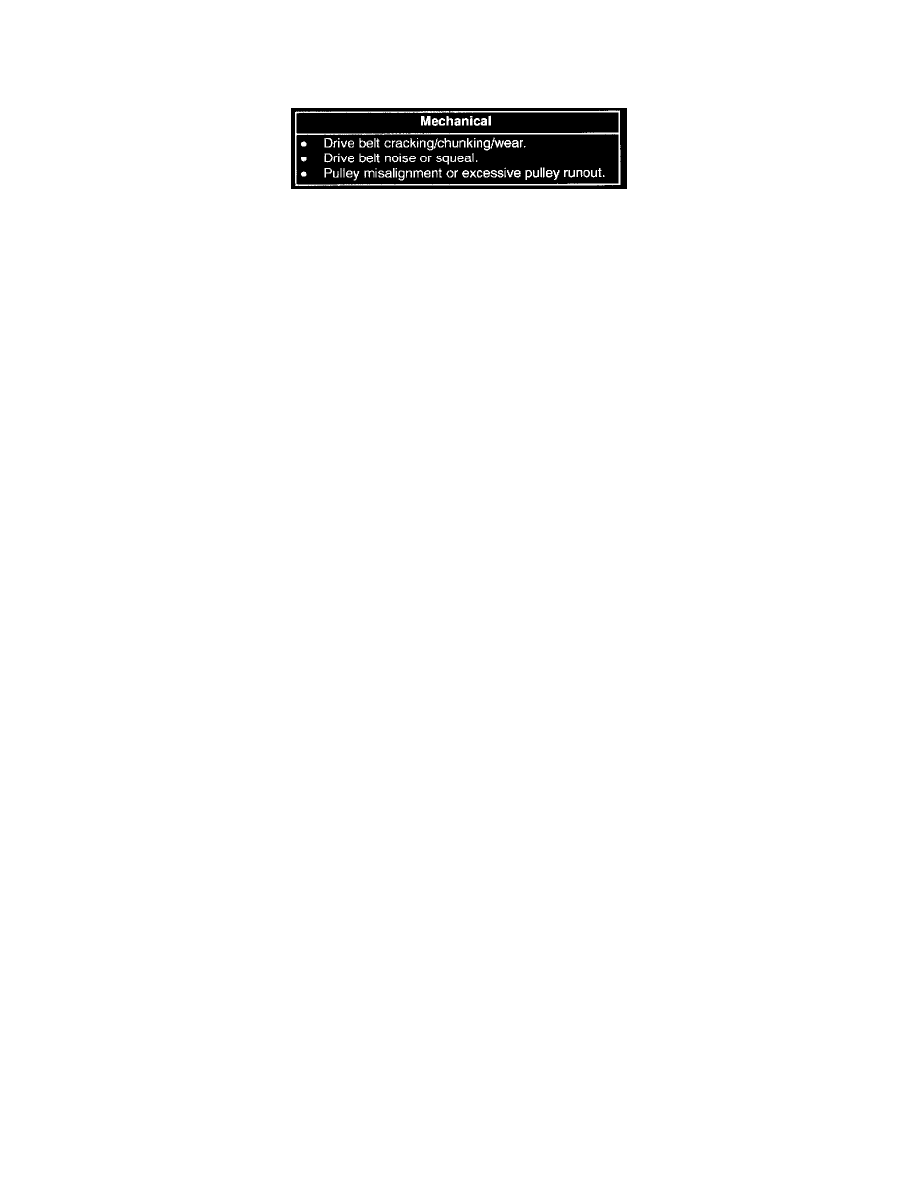B3000 SE Regular Cab 4WD V6-3.0L OHV (1998)

Drive Belt: Initial Inspection and Diagnostic Overview
INSPECTION
1. Verify the customer's concern by operating the engine to duplicate the condition.
2. Inspect to determine if any mechanical concerns listed in the above image apply.
3. Inspect for drive belt cracking/chunking/wear.
4. If the concerns remain after inspection, determine the symptoms and go to the symptom chart.
Under severe operating conditions (high temperature, low humidity), drive belt rib cracking can occur at less than 96,000 km (60,000 miles). Drive
belt rib cracking (cracks across grooves):
-
is not a reason for concern.
-
has no detrimental effect on drive belt performance. Cracks parallel to grooves are acceptable.
The drive belt is still perfectly functional until rib chunking occurs. Drive belt chunking is where the rubber material actually chunks out
between the cracks. The drive belt should be replaced if chunking occurs.
5. If the concern(s) remains after inspection, determine the symptoms and go to the Symptom Chart.
Drive Belt Squeal Inspection
Caution: The drive belt tensioner has no provision for adjustment and will be damaged if forced to travel beyond its operating range. Automatic
tensioners are calibrated at the factory to provide the correct amount of tension to the belt. There is no need to check tensioners for proper tension.
Drive belt squeal is an intermittent noise that occurs when the drive belt slips on a pulley during certain conditions such as:
-
engine start-up.
-
rapid engine acceleration.
-
A/C clutch engagement.
Drive belt squeal can occur under the following conditions:
-
The A/C discharge pressure goes above 2895 kPa (420 psi). This can occur if:
-
The A/C system is overcharged.
-
The A/C condenser airflow is blocked.
-
The engine cooling fan is not engaging fully at idle. Any of the accessories are damaged, have a worn or damaged bearing or internal torsional
resistance above normal for any reason. All of the accessories should be rotatable by hand in the unloaded condition. If any are not, the accessory
should be inspected.
Note: If fluid does get on the drive belt during service, clean the drive belt with soap and water and thoroughly rinse with clean water. The drive
belt does not have to be replaced if no apparent damage has occurred. If fluids get on the drive belt. This would include power steering fluid,
engine coolant, engine oil and air conditioning system lubricant.
-
The drive belt is too long. It will be evident by the arm of the drive belt tensioner resting on the stop. If the drive belt tensioner is resting on the
stop, replace the drive belt.
Note:
-
The drive belt tensioner arm should rotate freely without binding. The drive belt tensioner is worn or damaged.
Drive Belt-Alignment Inspection
Caution: Incorrect drive belt installation will cause excessive drive belt wear and may cause the drive belt to come off the drive pulleys.
Note: Original equipment drive belts are made of a special cord construction and are subjected to special testing before they are approved for use.
Replacement drive belts, other than O.E.M., may track differently/improperly. If a replacement drive belt tracks improperly, the drive belt should be
replaced with an O.E.M. drive belt to avoid performance failure or loss of drive belt during cold operation.
With the engine running, check drive belt tracking (the position of the drive belt on one of the grooveless pulleys, idlers or drive belt tensioner. If the
edge of the drive belt rides beyond the edge of the pulley, noise and premature wear may result). If a drive belt tracking condition exists, visually
check the drive belt tensioner for damage, especially the mounting pad surface. If the drive belt tensioner is not installed correctly with the locating
pins in the locating holes, the mounting surface pad will be out of position. This will result in abnormal drive belt tension and chirp and squeal noises.
If the above procedures do not correct the drive belt noise, try replacing the drive belt with a known good original equipment drive belt. However, the
drive belt noise may return (with mileage) if one of the above conditions still exists uncorrected.
